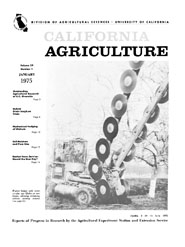


University of California
California Agriculture
|
|||
|
|||

Cover:
Walnut hedger with seven circular saw blades on two booms, allowing trimming without turning around.
January 1975
Volume 29, Number 1 News and opinion |
|||
|
University of California, 1301 S. 46th St., Bldg. 478 Richmond, CA
|